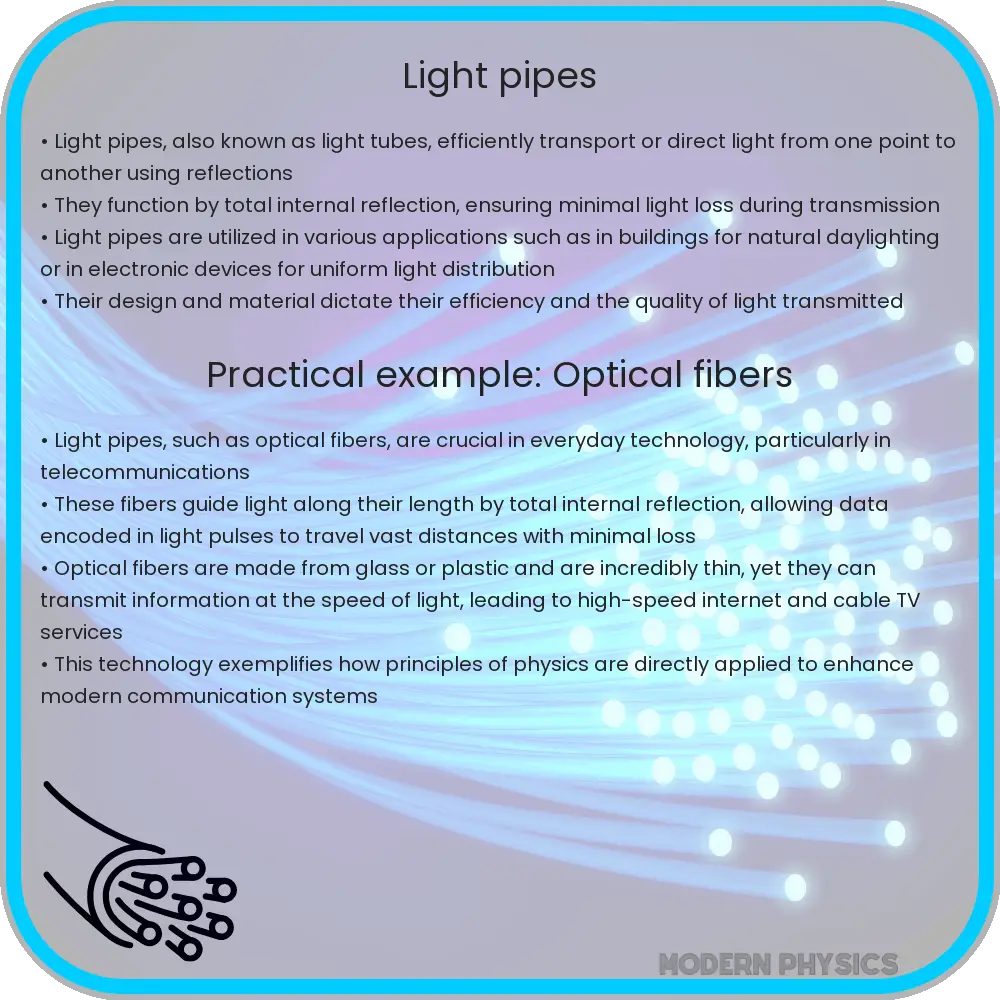Explore the benefits of light pipes in efficient light transmission and design clarity, covering materials, principles, and diverse applications.

Introduction to Light Pipes: Enhancing Efficiency and Clarity
Light pipes, also known as light tubes or light guides, are physical structures designed for the purpose of transmitting or distributing light from one point to another. Utilized in a wide range of applications, from architectural lighting to enhancing the brightness of displays, light pipes play a crucial role in modern lighting design. Their efficiency in transmitting light with minimal loss makes them indispensable in areas where natural or artificial light needs to be guided over distances or diffused uniformly.
The Science Behind Light Pipes
At the core of light pipe technology is the principle of total internal reflection (TIR). TIR occurs when light strikes the boundary between two materials at an angle greater than the critical angle, with the condition that the light is traveling from a medium with a higher refractive index (n1) to one with a lower refractive index (n2). This phenomenon prevents light from escaping the light pipe, allowing it to travel long distances with minimal loss.
Materials and Design Considerations
The choice of material for a light pipe is critical to its performance. Common materials include acrylic (PMMA), polycarbonate (PC), and glass. Each material has its specific properties, such as clarity, resistance to UV light, and thermal stability, which influence the light pipe’s efficiency and durability. The design of a light pipe, whether straight, curved, or flexible, also significantly affects its ability to transmit light effectively. Factors such as the light pipe’s diameter, length, and the smoothness of its internal surfaces are meticulously optimized to maximize light transmission and minimize dispersion or loss.
Applications of Light Pipes
Light pipes find applications in a myriad of fields, demonstrating their versatility and efficiency. In architecture, they are used to channel natural daylight into spaces that lack direct access to exterior windows, significantly reducing the reliance on artificial lighting. In electronics, light pipes are employed to direct light from LEDs to the surface of a device, enhancing the brightness and visibility of indicators and displays. Their use in automotive lighting, medical devices, and street lighting further underscores the wide-ranging impact of light pipes on improving illumination while conserving energy.
Advancements and Future Prospects
The continuous evolution of light pipe technology underscores its growing importance in sustainable and efficient lighting solutions. Recent advancements include the development of smart light pipes equipped with photovoltaic cells that not only transmit but also convert sunlight into electricity, further enhancing energy efficiency. Additionally, the integration of dynamic control systems enables the adjustment of light intensity and direction in real-time, responding to changing environmental conditions and user needs.
Challenges and Considerations
Despite their numerous benefits, light pipes face challenges related to installation complexity and cost, especially in retrofitting existing buildings or in applications requiring highly customized designs. Moreover, the effectiveness of light pipes can be influenced by external factors such as weather conditions, necessitating the need for supplementary lighting sources to ensure consistent illumination levels.
Environmental Impact and Sustainability
Light pipes offer a green lighting solution by maximizing the use of natural light, which can significantly reduce energy consumption and carbon footprint. By decreasing the reliance on artificial lighting, they contribute to the sustainable management of resources and promote environmental well-being. Furthermore, the use of recyclable materials in the manufacturing of light pipes aligns with the principles of circular economy, further enhancing their environmental benefits.
Conclusion
Light pipes stand at the intersection of innovation, efficiency, and sustainability in the realm of lighting design. By leveraging the principles of total internal reflection and advancements in materials science, light pipes offer a versatile solution for transmitting light with remarkable clarity and minimal loss. Their application across diverse fields, from architecture to electronics, underscores their potential to revolutionize how we harness and distribute light. As technology progresses, the future of light pipes looks bright, promising enhanced performance, greater energy savings, and a reduced environmental impact. Embracing light pipe technology represents a step forward in our quest for sustainable and efficient lighting solutions, illuminating the path towards a brighter and greener future.
Is this conversation helpful so far?
